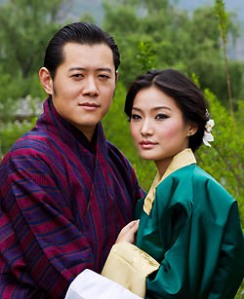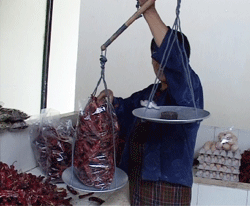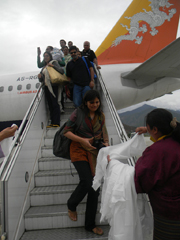Bhutan Thimphu Festival Tour
Join the colorful Thimphu Festival Tour. Visit Bhutan at the time of Thimphu Tsechu the grandest festivals in Bhutan. The Thimphu Festival is a religious festival where masked dances are performed to instruct the onlookers in the ways of Dharma. These are also occasions where Bhutanese people dress in their finest ethnic costumes. During the Thimphu Festival Tour you can witness various religious masked dances performed in the courtyards of the Dzong of the area. Our special festival tours visit Bhutan during the famous and colorful Thimphu Festival.
Day 1: Arrival Paro International Airport.
During the journey to Paro, one will experience from the left hand side of the plane, breath taking view of Mount Everest, Kanchenjunga and other famous Himalayan peaks, including the sacred Chomolhari and Mount Jichu Drake in Bhutan. On the arrival at Paro International Airport, The representative, your tour guide and driver will receive you and escort you to the hotel. After a brief rest at the hotel and tea/coffee, drive to the National Museum (Ta-Dzong). This was actually the Watch Tower of Paro Rinpung Dzong. It was converted to the National Museum in 1968. Visit the Paro Rinpung Dzong. This massive fortress is located on a hill top above the Pachu (Paro River) of Paro Valley. You have to walk about 15 minutes by crossing an ancient wooden bridge built in typical Bhutanese architect. The Dzong houses the District Administration Office and the District Monk Body. It was built in 1645 A.D. Lunch at Hotel. After Lunch Visit Kyichu Lhakhang (Lhakhang means Monastery). Kyichu Lhakhang was built in 659 A.D. by King Songtsen Gampo of Tibet. It is considered one of the holiest places in Bhutan as it marks the advent of Buddhism in the country. It is one of the 108 such temples built by him for spreading Buddhism in this region. Drive to the Paro village town and explore the town. Altitude of Paro is 2260m.
Overnight: Hotel in Paro.
Day 2: Paro – Paro
Drive for 15kms and reach the base of Famous Tiger’s Nest “TAKTSANG” Monastery and hike up which would take Two Hours up and approximately One Hour down. Stop at Taktsang Tea House “Cafeteria” for refreshment of Tea & Coffee. Taktsang is at 2900mts. Hike for another half an hour and you reach the Great and Magnificent Taktsang where you will be greets by the monks who live there and Special Bhutanese Butter Tea will be served with Snacks. Visit the most important monastery were the Guru Rimpoche was flying on a Flamming Tigress from Singye Dzong in Eastern Bhutan to here and meditated for Three Months and flourishment of Buddhism in Paro started from 8th Century. Walk down hill and drive to Drugyal Dzong and on the way enjoys the view of the Taktsang Monastery, also known as “Tiger’s Nest temple”. Near the Drugyal Dzong, if the sky is clear we can see the Mt. Chomolhari on the background.
Overnight: Hotel in Paro.
Thimphu is the Capital City of Bhutan but for the Buddhist Monk body moves to Punakha in winter and their Summer Capital District is Thimphu but Winter s Punakha because it is cold in Thimphu during winter and Punakha is just perfect at 1300mts
Day 3: Paro – Thimphu
The drive to Thimphu will take roughly Two Hours. Thimphu is the capital city of Bhutan since from 1974. Punakha used to the capital city of Bhutan before that.
For the first one hour you will follow the Pa-Chu (Paro River) and reach Chuzom where the Thimphu River meets the Paro River and forms Wang-Chu (Chu means Water, River or Stream). Chuzom is a four direction motor road junction where one road leads to Thimphu, one to Phuentsholing the border town to India, one to Haa valley and one where you drove from Paro. It will take another One hour from here to Capital city, Thimphu. Check in the Hotel and after short rest visit National Memorial Stupa, built in 1874 by Royal Queen Mother and dedicated to the father of Modern Bhutan, the Late His Majesty the Third King of Bhutan. The Memorial Stupa, built in 1974 by Royal Queen Mother and dedicated to the Father of Modern Bhutan, The Third King of Bhutan. This Tibetan & Bhutanese Architecture mixed Stupa has got three different sects of Buddhism such as Gongdu on the Top floor, Drukpa Kagyud on Middle with Second Buddha figure facing the Sun Rise and on the Ground Floor it is the Phurba.
Day 4: Thimphu – Thimphu
Full Day Thimphu Festival
Overnight: Hotel in Thimphu
Day 5: Thimphu – Thimphu
Full Day Thimphu Festival
Overnight: Hotel in Thimphu
Day 6: Thimphu – Thimphu
A.M Thimphu Festival, Lunch in Town, after lunch drive to BBS Tower to get the magnificent picture and view of Thimphu and you can also see our Queens Palaces. Visit to Thimphu Mini Zoo where you can see our National Animal “TAKIN” which has a head of a goat and body of a cow, believed to be made by great Devine Madman in the 16th Century. Visit national Library, School of Thirteen Arts and Crafts, National institute of Traditional Medicines.
Overnight: Hotel in Thimphu.
Day 7: Thimphu – Punakha
After breakfast drive to Winter Capital for the Monastic Body, Punakha at 1300m.
One hour drive reach you to Dochula Pass at 3150mts where you can see and enjoy the Eastern Himalayas in a Panoramic View and best picture time for group of Bhutanese Style of Stupas, as there are 108 Stupas built by Her Majesty for the well being of the Nation and Love Live His Majesty. It descends to Punakha and Wangdue at 1300mts which will take another two hours. Visit Historic and one of the most beautiful Punakha Dzong built in 1637 by Great Zhabdrung Rimpoche who unified Bhutan in 17th Century.
Overnight: Hotel in Punakha
Day 8: Punakha – Punakha
After breakfast walk to the famous Devine Madman’s Monastery The Chhimi Lhakhang “No Dog Monastery” built in 1499. Today it is very popular because couples who are married for so many years and don’t have childrens but always desired go there and get blessed from the wodden Phallus and in another Nine months the wife gets pregnant. We will visit the monastery and meditate and picnic lunch will be served outside the monastery in a lush green ground. After Lunch drive to Punakha and visit the beautiful and legendary Khamsum Yuley Namgyal Monastery built by Her Majesty the Queen mother of our Crown Prince.
Overnight: Hotel in Punakha
Day 9: Punakha – Paro
After breakfast drive to Paro. Stop in Thimphu for lunch. After lunch further drive to Paro
Overnight: Hotel in Paro
Day 10: Depart Bhutan
After breakfast drive to Paro International Airport to board.
Thank You very much for visiting Bhutan with us and we look forward in hearing and re-organizing same Pilgrimage Tour for you, your family members and Friends!!!






